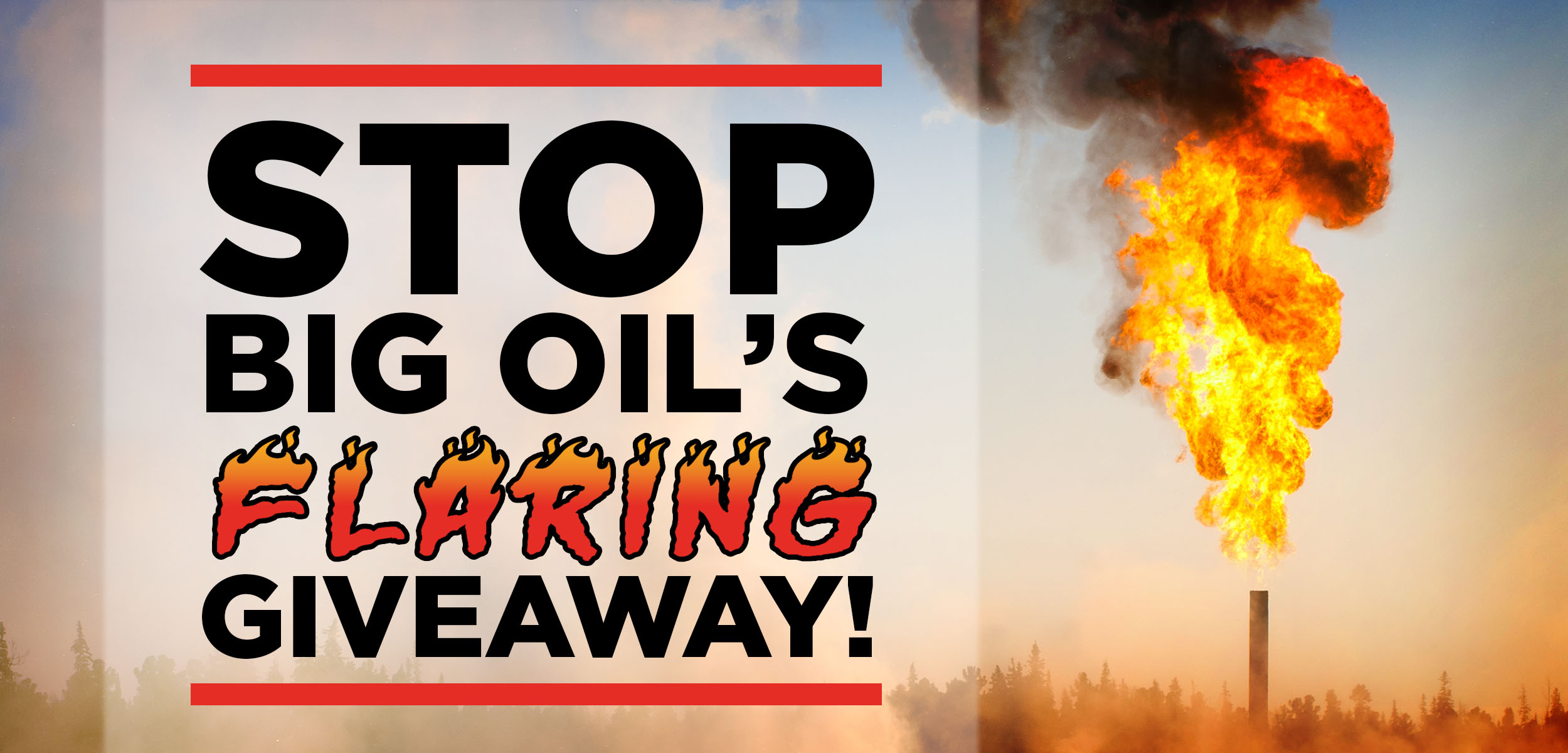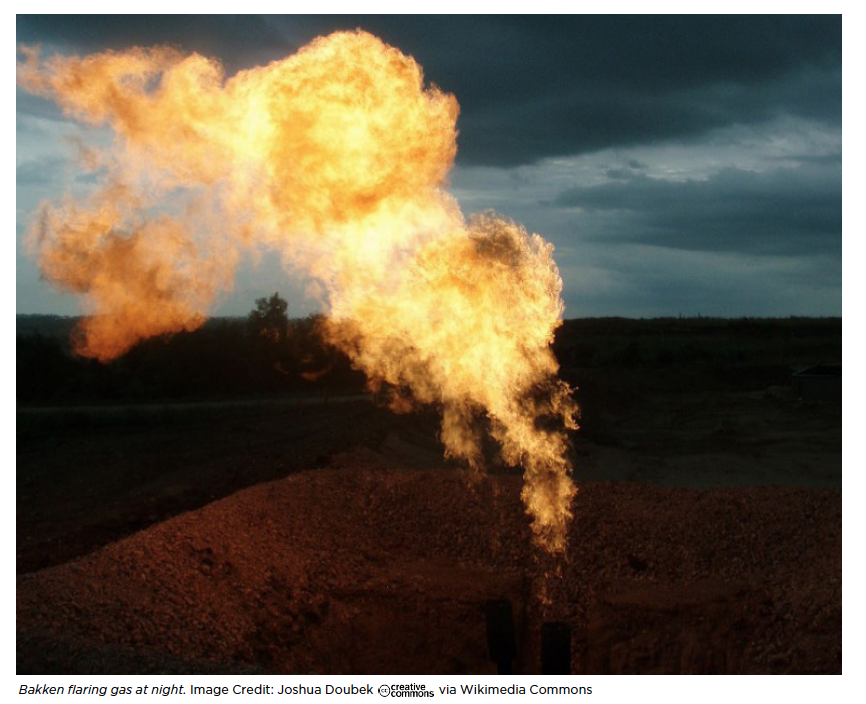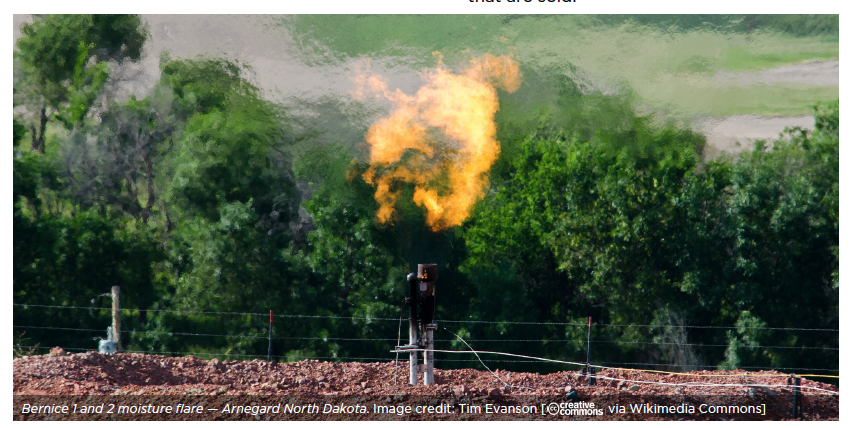- Blog
- Food & Agriculture
- The Big Gas Giveaway: flaring, the Congressional Review Act, and Trumps present to BigOil
The Big Gas Giveaway: flaring, the Congressional Review Act, and Trumps present to BigOil

Donate Now!
Your contribution will benefit Friends of the Earth.
Stay Informed
Thanks for your interest in Friends of the Earth. You can find information about us and get in touch the following ways:
The Congressional Review Act is a powerful and until recently rarely used legislative tool. It can bypass the Senate’s filibuster to reverse recently finalized federal regulations with only a simple majority from Congress. Successfully deployed only once before, it could be used to devastating effect in the coming weeks against protections for workers, consumers, and the environment.
One of the first targets is expected to be a new regulation protecting taxpayers and the climate from one of the most over-looked fossil fuel subsidies on the books: the royalty-free venting and flaring of natural gas on public and tribal lands.
Finishing work on the rule in November was supposed to be one of the last pieces of President Obama’s climate legacy?—?and its reversal under the Congressional Review Act could be one of the first casualties of the Trump administration.
What exactly is happening?
The rule is fairly simple. It would limit the practice of releasing natural gas directly into the air?—?venting?—?and in certain cases require equipment upgrades to mitigate leaks. It would impose rising targets to lower the amount of natural gas that can be burned away?—?or flared?—?for free. And it would create clearer standards around the use of natural gas to power equipment at drilling sites–a practice known as ‘beneficial use.’
The economic benefits of these reforms far outweigh the costs. Oil companies operating on public and tribal lands would absorb as much as $174 million per year over the next decade, but the total annual benefits over the same period would reach $354 million. This ratio is based on the simple fact that pollution isn’t free.
Flaring produces climate-warming CO?, as well as co-pollutants like soot and black carbon, while venting sends the super-potent greenhouse gas methane directly into the atmosphere, where it inflicts 86 times the global warming potential of CO? over a 20-year time span.
Addressing these problems through regulation turns out to be much more economical than doing nothing.
Another benefit is a potential $800 million in additional royalties to taxpayers over the next decade. The previous policy gave BLM field offices broad discretion not only to permit flaring, but to exempt flared gas from royalty payments if the agency deemed it ‘unavoidably lost.’ This was only supposed to happen if an operator could prove to the BLM that the choice was between building the infrastructure necessary to capture the gas and leaving oil reserves stranded in the ground. Unfortunately, as the hydraulic fracturing boom spread across the country, it became increasingly clear that the BLM was abusing its discretion to the benefit of oil producers and the detriment of taxpayers and tribes.
Estimates vary, and the record-keeping on lost gas is notoriously bad, but the total volume of flaring rose 134 percent between 2009 and 2013, from about 18.6 billion cubic feet (bcfs) to 43.60 bcfs. Although it was far from perfect, the rule finalized in November was designed to replace a status quo in which energy companies were handed significant amounts of a public resource for free?—?and as Congress prepares to reverse this regulation, it is that status quo that threatens to return.
Clear winners from free gas?
Who would benefit the most if this regulation were reversed? The clearest answer can be found in a Freedom of Information Act request filed by Friends of the Earth in 2015. We wanted to know which companies were flaring and venting the most, what the costs were to taxpayers and the climate, and how much gas was being used for free on lease sites. This is all information oil producers are required to report on a monthly basis to the Office of Natural Resources Revenue (ONRR), but the agency only provided a partial response to our request, claiming that much of the data either didn’t exist or was confidential.
Nevertheless, the agency did provide us with total volumes for gas flared, vented, and beneficially used on public lands for the decade from 2004 to 2014. If the new rule is partly designed to capture royalties from losses like these, then these numbers are the best and only picture of who stands to gain from its repeal, and by how much.
Unfortunately, those most harmed would be the front line communities that are too often forgotten and ignored.
We are publishing the data set in its entirety? — a spreadsheet with over 15,000 lines!?—?but these are some of the highlights:
- ExxonMobil and its subsidiary XTO [1] received over 40 million mcfs of free natural gas throughout the data set, totaling over 38 million mcfs of onsite use and 2.5 million mcfs of flaring. The estimated market value for the lost gas is over $203 million and the flaring alone is the climate change equivalent to burning over 330,000 barrels of oil.
- Devon Energy received 17 million mcfs of natural gas throughout the data set, totaling 14.45 million mcfs of onsite use and 2.8 million mcfs of flaring. The total value of lost gas is estimated at over $83 million.
- Encana Energy received 20.1 million mcfs of natural gas throughout the data set totaling an estimated market value of over $102 million. This includes over 137,000 mcfs of venting and 1.1 million mcfs of flaring?—?the climate change equivalent to burning nearly 70 million pounds of coal. [2]
The striking thing about the data is the preponderance of beneficial use. In volumetric terms, it is a far larger source of royalty-free gas than either flaring or venting. Admittedly, the final rule wouldn’t solve this problem, but it would mitigate some of the excess. Electric power generated from onsite natural gas and sold into the grid would be subject to royalties, and tighter standards of approval would be applied to natural gas removed from the lease site and returned after treatment. The reforms fall short of the logical and legal solution?—?simply charging royalties for everything taken out of the ground?—?but still present a better chance of capturing royalty revenue than the status quo.
What this data doesn’t show
- Tribal and mixed leases…completely. When we filed the FOIA request with ONRR in 2015, much of the reply was redacted. ONRR claims that data on tribal resources are exempt from disclosure, and so it is unclear which companies are getting the most free gas from tribal land (although the failure of the BLM to capture royalties from flared gas has been a consistent source of controversy with tribes). Another gap in the data is from mixed leases, where ownership of minerals is split between some combination of state, federal, tribal, and public property. Most of the flaring?—?over 75 percent?—?occurs on these mixed leases, but in their official response to a second records request, ONRR claimed that it had no way to isolate the public portion of gas lost from mixed leases.
- Royalties lost…necessarily. Even before the new rule, the BLM had the authority to deem flared gas “avoidably lost” and to charge royalties for it. But a separate set of data on revenue indicates that overwhelmingly it did not, with the possible exception of one field office in New Mexico starting around 2014. However, the data we received from ONRR gives no indication of the exact composition of the lost gas or whether it was royalty-free?—?it simply provides the volumes. This leaves estimation based on volume and fair market value the best and only approximation.
Conclusion
If the Congressional Review Act is brought to bear against the flaring rule, it wouldn’t just erase a single regulation?—?it would block all future administrations from developing anything similar. This would be a disaster.
[1] ExxonMobil did not acquire XTO until 2009, but the data sets are integrated here for clarity.
[2] The climate costs of flaring are based on the EPA emissions calculator and assume 1 mcf of flared gas per 128.4 pounds of CO?. The economic value of the gas from 2004 to 2012 is based on EIA annual wellhead price estimates, while the value for the remaining two years for which there is no EIA data are derived from the price estimates converted to mcfs from mmbtus by ICF.


